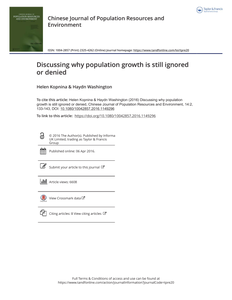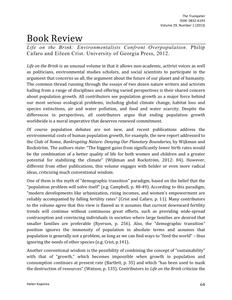Due to a number of factors outlined in this article, the issue of population growth is excluded from the sustainability discussion. In this article, we explore some of the ethical presumptions that underlie the issues linking population growth and sustainability. Critics argue that action to address population creates social and economic segregation, and portray overpopulation concerns as being “anti-poor,” “anti-developing country,” or even “antihuman.” Yet, de-linking demographic factors from sustainability concerns ignores significant global realities and trends, such as the ecological limits of the Earth, the welfare and long-term livelihood of the most vulnerable groups, future prospects of humanity, as well as the ecosystems that support society. https://doi.org/10.1080/10042857.2016.1149296 LinkedIn: https://www.linkedin.com/in/helenkopnina/
MULTIFILE

At present, leading international agencies, such as the United Nations Environmental Programme, are largely focused on what they claim to be ‘win-win’ scenarios of ‘sustainable development’ rhetoric. These combine social, economic and environmental objectives. However, as noted by the ‘Scientists’ Warning to Humanity’, environmental integrity is the essential precondition for the healthy functioning of social and economic systems, and thus environmental protection needs to be prioritized in policy and practice. Ecological sustainability cannot be reached without realizing that population growth and economic growth, with attendant increased rates of depletion of natural resources, pollution, and general environmental degradation, are the root causes of unsustainability. This article argues that to strategically address ecological unsustainability, the social, economic and political barriers to addressing the current economic model and population growth need to be overcome. Strategic solutions proposed to the current neoliberal economy are generic – namely, degrowth, a steady-state economy, and a ‘circular economy’. Solutions to demographic issues must be sensitive to the countries' cultural, social, political and economic factors to be effective as fertility differs from country to country, and culture to culture. As discussed here, Mediterranean countries have the lowest fertility in the world, while many countries in Africa, and some in Asia, South America have stable but consistently high birthrates. This is discussed using three case studies - Tanzania, Italy, and Cambodia, focusing on the "best case" policy practice that offers more realistic hope for successful sustainability. https://doi.org/10.1007/s41207-019-0139-4 LinkedIn: https://www.linkedin.com/in/helenkopnina/
MULTIFILE

There is increasing evidence that humans are not living sustainably. There are three major drivers of the unsustainable approach: population, consumption and the growth economy. There is widespread denial about these issues, but they clearly need to be addressed if we are to achieve any of the possible sustainable futures. The first and second versions of the ‘World Scientists Warning to Humanity’ both highlight the problem of increasing human population, as do the IPCC and IPBES reports. However, all have been largely ignored. The size of an ecologically sustainable global population is considered, taking into account the implications of increasing per capita consumption. The paper then discusses the reasons why society and academia largely ignore overpopulation. The claim that discussing overpopulation is ‘anti-human’ is refuted. Causal Layered Analysis is used to examine why society ignores data that do not fit with its myths and metaphors, and how such denial is leading society towards collapse. Non-coercive solutions are then considered to reach an ecologically-sustainable human population. LinkedIn: https://www.linkedin.com/in/helenkopnina/
MULTIFILE

Life on the Brink is an unusual volume in that it allows non-‐academic, activist voices as well as politicians, environmental studies scholars, and social scientists to participate in the argument that concerns us all, the argument about the future of our planet and of humanity. The common thread running through the essays of two dozen nature writers and activists hailing from a range of disciplines and offering varied perspectives is their shared concern about population growth. All contributors see population growth as a major force behind our most serious ecological problems, including global climate change, habitat loss and species extinctions, air and water pollution, and food and water scarcity. Despite the differences in perspectives, all contributors argue that ending population growth worldwide is a moral imperative that deserves renewed commitment. https://www.linkedin.com/in/helenkopnina/
DOCUMENT

The use of growth monitoring and promotion (GMP) has become widespread. It is a potential contributor towards achieving the Millennium Development Goals of halving hunger and reducing child mortality by two-thirds within 2015. Yet, GMP appears to be a prerequisite for good child health but several studies have shown that there is a discrepancy between the purpose and the practice of GMP. The high prevalence of malnutrition in many developing countries seems to confirm this fact. A descriptive qualitative study was carried out from April to September 2011. Focus group discussions and in-depth interviews were conducted amongst mothers and health workers. Data were analyzed using a qualitative content analysis technique, with the support of ATLAS.ti 5.0 software. The results suggest that most mothers were aware of the need for regular weight monitoring while health workers also seemed to be well-aware and to practise GMP according to the international guidelines. However, there was a deficit in maternal knowledge with regard to child-feeding and a lack of basic resources to keep and/or to buy healthful and nutritionally-rich food. Furthermore, the role of the husband was not always supportive of proper child-feeding. In general, GMP is unlikely to succeed if mothers lack awareness of proper child-feeding practices, and if they are not supported by their husbands.
DOCUMENT

Exposures to ionizing radiation frommedical examinations are on the rise. An important cause for this has been the advent and ever-increasing use of computed tomography (CT) scans for diagnostic purposes. It is often implied that population aging contributes significantly to this rise. Here, the trends in population statistics are compared to the trend in the number of CT scans in the Netherlands for the period 2002–2010. It is concluded that population growth and population aging cannot explain the observed rise in CTexaminations. In fact, these factors contribute only 17% to this rise, indicating that there must be other factors that are far more important.
LINK
Some researchers insist that sustainability should be represented as a continuous quest, doubting that there is the ‘right’ way to be sustainable. Acknowledging the immensity of sustainability challenges, this article takes a different perspective, arguing that without understanding of concrete barriers and seeking solutions, the challenge of addressing unsustainable practices becomes unsurmountable. This article will summarize research in sustainability literature that indicates that sustainability requires a constant human population, as well as ecologically benign method of production. This article will survey a number of helpful frameworks that address the key obstacles to sustainability, namely population growth, and unsustainable production and consumption. These frameworks are discussed in the context of business-level solutions and production systems. As illustrated by examples of best practices as well as potential pitfalls associated with each system, these systems have the potential to move the quest for sustainability beyond ‘business as usual.’ https://doi.org/10.1007/s10668-015-9723-1 LinkedIn: https://www.linkedin.com/in/helenkopnina/
MULTIFILE

The Dutch greenhouse horticultural industry is characterized by world leadership in high-tech innovation. The dynamics of this playing field are innovation in production systems and automation, reduction in energy consumption and sharing limited space. However, international competitive advantage of the industry is under pressure and sustainable growth of individual enterprises is no longer a certainty. The sector's ambition is to innovate better and grow faster than the competition in the rest of the world. Realizing this ambition requires strengthening the knowledge base, stimulating entrepreneurship, innovation (not just technological, but especially business process innovation). It also requires educating and professionalizing people. However, knowledge transfer in this industry is often fragmented and innovation through collaboration takes up a mere 25-30% of the opportunities. The greenhouse horticulture sector is generally characterized by small scale, often family run businesses. Growers often depend on the Dutch auction system for their revenues and suppliers operate mainly independently. Horizontal and vertical collaboration throughout the value chain is limited. This paper focuses on the question: how can the grower and the supplier in the greenhouse horticulture chain gain competitive advantage through radical product and process innovation. The challenge lies in time- to-market, in customer relationship, in developing new product/market combinations and in innovative entrepreneurship. In this paper an innovation and entrepreneurial educational and research programme is introduced. The programme aims at strengthening multidisciplinary collaboration between enterprise, education and research. Using best practice examples, the paper illustrates how companies can realize growth and improve innovative capabilities of the organization as well as the individual by linking economic and social sustainability. The paper continues to show how participants of the programme develop competencies by means of going through a learning cycle of single-loop, double-loop and triple loop learning: reduction of mistakes, change towards new concepts and improvement of the ability to learn. Furthermore, the paper discusses our four-year programme, whose objectives are trying to eliminate interventions that stimulate the innovative capabilities of SME's in this sector and develop instruments that are beneficial to organizations and individual entrepreneurs and help them make the step from vision to action, and from incremental to radical innovation. Finally, the paper illustrates the importance of combining enterprise, education and research in networks with a regional, national and international scope, with examples from the greenhouse horticulture sector. These networks generate economic regional and national growth and international competitiveness by acting as business accelerators.
DOCUMENT

Much of global passenger transport is linked to tourism. The sector is therefore of interest in studying global mobility trends and transport-related emissions. In 2005, tourism was responsible for around 5% of all CO 2 emissions, of which 75% were caused by passenger transport. Given the rapid growth in tourism, with 1.6 billion international tourist arrivals predicted by 2020 (up from 903 million in 2007), it is clear that the sector will contribute to rapidly growing emission levels, and increasingly interfere with global climate policy. This is especially true under climate stabilisation and "avoiding dangerous climate change" objectives, implying global emission reductions in the order of -50% to -80% by 2050, compared to 2000. Based on three backcasting scenarios, and using techniques integrating quantitative and qualitative elements, this paper discusses the options for emission reductions in the tourism sector and the consequences of mitigation for global tourism-related mobility by 2050. It ends with a discussion of the policy implications of the results.
DOCUMENT
The authors consider the reality that endless economic growth on a finite planet is unsustainable, especially if society has exceeded ecological limits. The paper examines various aspects of society's endless growth predicament. It reviews the idea that there are 'limits to growth'; it then considers the 'endless growth mantra' within society. The paper then considers the 'decoupling' strategy and its merits, and argues that it is, at best, a partial solution to the problem. The key social problem of denial of our predicament is considered, along with the contribution of anthropocentric modernism as a worldview that aids and abets that denial. Finally, the paper outlines some potential solutions to our growth predicament. https://www.ecologicalcitizen.net/article.php?t=insanity-endless-growth https://www.linkedin.com/in/helenkopnina/
MULTIFILE
